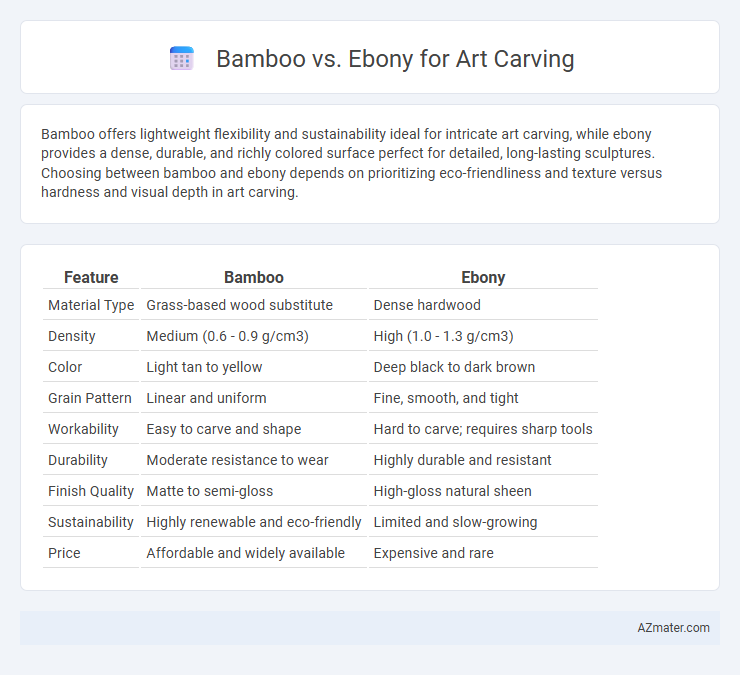Bamboo offers lightweight flexibility and sustainability ideal for intricate art carving, while ebony provides a dense, durable, and richly colored surface perfect for detailed, long-lasting sculptures. Choosing between bamboo and ebony depends on prioritizing eco-friendliness and texture versus hardness and visual depth in art carving.
Table of Comparison
| Feature | Bamboo | Ebony |
|---|---|---|
| Material Type | Grass-based wood substitute | Dense hardwood |
| Density | Medium (0.6 - 0.9 g/cm3) | High (1.0 - 1.3 g/cm3) |
| Color | Light tan to yellow | Deep black to dark brown |
| Grain Pattern | Linear and uniform | Fine, smooth, and tight |
| Workability | Easy to carve and shape | Hard to carve; requires sharp tools |
| Durability | Moderate resistance to wear | Highly durable and resistant |
| Finish Quality | Matte to semi-gloss | High-gloss natural sheen |
| Sustainability | Highly renewable and eco-friendly | Limited and slow-growing |
| Price | Affordable and widely available | Expensive and rare |
Introduction to Bamboo and Ebony in Art Carving
Bamboo and ebony are prized materials in art carving for their distinct textures and visual appeal. Bamboo offers a lightweight, renewable resource with a smooth grain that enhances intricate carvings and fine details. Ebony, known for its dense, dark, and durable wood, provides a striking contrast and longevity, making it ideal for high-end, detailed sculptural art.
Material Properties: Bamboo vs Ebony
Bamboo offers lightweight flexibility and rapid regrowth, making it an eco-friendly choice for art carving with moderate hardness suitable for intricate details. Ebony features a dense, fine-grained wood known for its exceptional hardness and deep black color, providing durability and a luxurious finish ideal for high-end, detailed carvings. The contrasting material properties influence choice: bamboo excels in sustainability and ease of carving, while ebony delivers superior strength and aesthetic longevity.
Workability and Tool Compatibility
Bamboo offers excellent workability for art carving due to its lightweight, fibrous texture, and ease of cutting with both hand and power tools, making it ideal for detailed and intricate designs. Ebony, known for its dense, hard grain, presents greater challenges in carving but yields highly polished, durable finishes that are compatible with sharp, high-quality steel tools, including chisels and rotary devices. Selecting between bamboo and ebony depends on the desired intricacy and finish quality, with bamboo favored for flexibility and ebony for longevity and depth in artistic carvings.
Durability and Longevity of Carved Pieces
Bamboo offers moderate durability for art carving, prized for its lightweight and flexibility but prone to cracking over time if not properly treated. Ebony is renowned for its exceptional hardness and density, providing superior longevity and resistance to wear, making it ideal for detailed, long-lasting carved pieces. Artists seeking endurance and fine detail typically prefer ebony, while bamboo suits projects where sustainability and ease of carving are prioritized.
Aesthetic Qualities: Color, Grain, and Texture
Bamboo art carvings showcase a light golden hue with subtle linear grain patterns that create a smooth, natural texture, enhancing minimalist and contemporary designs. Ebony offers a striking contrast with its deep, jet-black color and dense fine grain, lending a luxurious and polished finish ideal for intricate, high-detail carvings. The tactile experience of bamboo is typically softer and warmer, while ebony provides a hard, glossy surface that accentuates sharp detail and refined craftsmanship.
Sustainability and Environmental Impact
Bamboo is highly sustainable for art carving due to its rapid growth rate, ability to regenerate without replanting, and minimal pesticide requirements, making it an eco-friendly material that reduces deforestation pressures. Ebony, on the other hand, grows very slowly and is often harvested unsustainably, contributing to deforestation and habitat loss, which raises significant environmental concerns. Choosing bamboo over ebony supports sustainable forest management and lowers the ecological footprint of art carving projects.
Cost and Availability Comparison
Bamboo offers a cost-effective and highly sustainable option for art carving, with wide availability due to its rapid growth and global cultivation, making it accessible for both amateur and professional carvers. Ebony, characterized by its dense, dark wood, commands a significantly higher price due to limited supply and slower growth rates, contributing to its rarity and higher market demand. Artists seeking affordability and environmental benefits often prefer bamboo, while those prioritizing premium quality and aesthetic appeal may invest in the more expensive, less accessible ebony.
Traditional and Cultural Significance
Bamboo holds deep cultural significance in many Asian traditions, symbolizing strength, flexibility, and resilience, and is often used in art carvings to reflect harmony with nature and spiritual themes. Ebony, prized for its dense, dark wood, is historically significant in African and South Asian cultures, representing luxury and status in traditional carvings that convey ancestral stories and religious motifs. Both materials carry rich symbolic meanings, with bamboo embodying organic growth and renewal, while ebony emphasizes permanence and prestige in cultural art forms.
Ideal Applications for Each Material
Bamboo excels in art carving projects requiring lightweight, flexible, and eco-friendly materials, making it ideal for intricate, organic designs or decorative household items. Ebony's dense, hard texture is preferred for fine detail work, durable sculptures, and luxury pieces where a polished, dark finish enhances visual impact. Artists select bamboo for sustainability and ease of carving, while ebony is chosen for its strength and rich aesthetic in high-end art carvings.
Choosing the Right Wood for Your Art Carving Project
Bamboo offers lightweight flexibility and a smooth grain ideal for intricate, delicate art carving, while ebony provides a dense, dark hardwood favored for its durability and striking contrast in detailed designs. Choosing between bamboo and ebony depends on the desired texture, color intensity, and carving complexity of your project, with bamboo better suited for fine, decorative pieces and ebony for robust, high-end artworks. Understanding each wood's workability, finishing properties, and longevity ensures your carved art meets both aesthetic and functional goals.

Infographic: Bamboo vs Ebony for Art Carving
 azmater.com
azmater.com